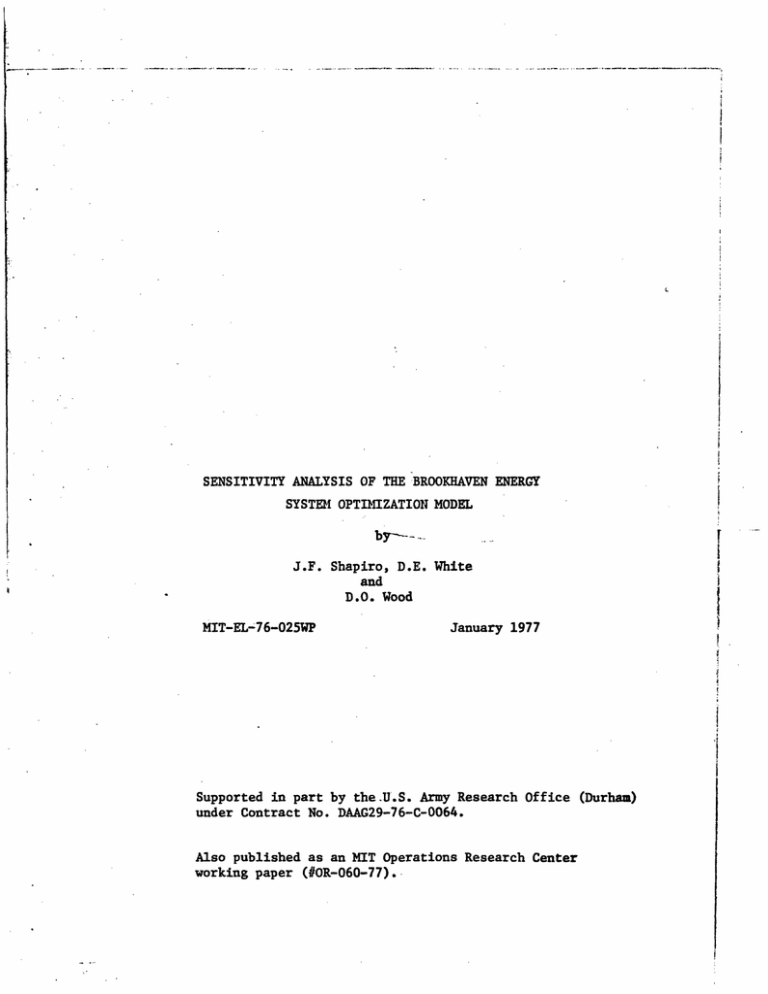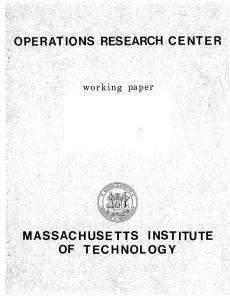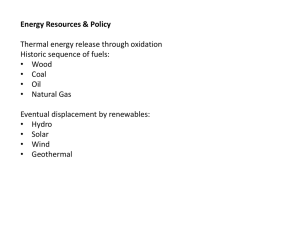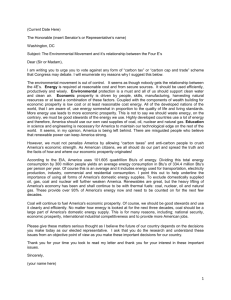Ir
advertisement

C- Al SENSITIVITY ANALYSIS OF THE BROOKHAVEN ENERGY SYSTEM OPTIMIZATION MODEL by--- Ir ..-. J.F. Shapiro, D.E. White and D.O. Wood MIT-EL-76-025WP January 1977 Supported in part by the.U.S. Army Research Office (Durham) under Contract No. DAAG29-76-C-0064. Also published as an MIT Operations Research Center working paper (#OR-060-77). I I I SENSITIVITY ANALYSIS OF THE BROOKHAVEN ENERGY SYSTEM OPTIMIZATION MODEL By J.F. Shapiro, D.E. White and D.O. Wood The Brookhaven Energy System Optimization Model (BESOM) is a linear programming (LP) model of the U.S. energy sector developed at the Brookhaven 1 National Laboratories (BNL). It has been used by ERDA as an analytical tool in a number of energy studies including "A National Plan for Energy Research, 2 Development and Demonstration." BESOM was used in ERDA-48 to evaluate the resource use and environmental effects of a number of future energy scenarios. It was used in ERDA-76 to study the trade-offs between different fuels with respect to various fuel characteristics such as capital versus operating costs, scarce resource usage, or dependence on imports. a joint study underway between BNL and Data Resources Currently, there is Incorporated to study the relationships between energy and economic growth. BESOM minimizes the cost of meeting given demand levels d measured in BTU's for a number of energy end uses such as space heat or automobile travel in a given year. The demand is met by converting and transporting primary supplies measured in si BTU's through a number of stages. A precise LP statement of BESOM is min E cijxij + i,j s.t. x j ij (la) - s i = 0 for all supplies i wx = d for all end uses j i ijxij E akijXij < bk for all k i 0 where 0 < wj PiSi i xij for all i,j, 0 Ss (lb) (lc) (d) Si for all i (le) < 1. 1 The model was originally proposed by Hoffman (1972) in his Ph.D. thesis; more recent developments and uses of the model are reviewed in Beller (1975). 2 See ERDA-48 (1975) and ERDA-76 (1976). 3 See Jorgenson (1975). 2 The supply quantity s i is a variable permitted to vary between 0 and an upper bound S i at constant unit price Pi. The coefficients wij reflect the efficiency of using supply i to meet end use . They are calculated, along with the cost coefficients cij, from The Reference Energy System which is a network representation of the various stages in the conversion and transmission process between supply and end use. In the ERDA-48 version of the model, there are 27 supply and 22 end use demand categories with xij variables linking each of the possible combinations (e.g., imported oil to space heat). Problem (la), (lb), (lc) and (le) with the supply variables si fixed is 4 a generalized transportation problem. This type of network optimization problem has been extensively analyzed in the literature including special 5 purpose algorithms. There are the additional constraints (ld) involving the transportation variables for environment and other factors. This suggests the use of Lagrangean relaxation methods on the additional constraints to exploit the special network structure thereby achieving faster and more 6 flexible solution methods. The purpose of this note is to report and reflect on some computational experimentation with BESOM used in the ERDA-48 study of the U.S. energy sector in 1985. The experimentation was motivated by our more general goal to develop and implement decomposition methods for energy planning models which combine LP submodels such as BESOM of processing and transmission of energy 7 commodities, with econometric supply and demand models. LP shadow prices play a central role in decomposing these planning models into their LP and econometric components, and it was these that we chose to calculate. 4 See Dantzig (1963); Chapter 21. 5 See Jewell (1962). 6 See Geoffrion (1974). 7 See Shapiro (1976). 3 Specifically, analyses on the the first expertments we performed were sensitivity supplies of coal, oil and gas to compute the shadow prices at various levels of supply as shown in Figures la, lb and lc. These shadow prices measure in dollars the value at the indicated supply levels to the U.S. energy sector with fixed demand in 1985 of another 106 Btus of coal, oil and natural gas. The large incremental changes in the shadow prices indicate Moreover, the infeasibility that the BESOM model is tightly constrained. which results if the supply of natural gas is lowered below the given level suggests the upper limit for that commodity was set to permit feasibility to be obtained. Primary fuels can substitute for each other to a certain extent in BESOM, but the total primary energy supply is limited. The infea- sibility for natural gas would imply that there are uses of natural gas for which there are no substitutes. Another phenomenon observed for the ERDA-48 LP model was the existence of numerous alternative optima. Specifically, there were 20 non-basic variables at zero reduced cost, compared with 149 basic variables, which could enter the basis at a positive level. Thus, the LP model treated these activities as the same although there were substantial differences between 8 some of them (e.g., underground versus stripmining). It is the nature of LP models to produce the lumpy or step function shadow price structure shown in Figure 1. Each level part of the step function corresponds to a specific optimal LP basis, and the large incremental change is indicative of significant changes in the basis structure. Smooth changes in the shadow prices would result if there were some nonlinearities in the model; for example, if there were nonlinear convex costs associated with the flows in the generalized transportation model derived from The Reference Energy System. These cost functions would require more data to construct than the linear ones, and the resulting model would be more difficult to optimize, although not seriously so. 8 The identification of the cause it is given by White (1976). of this difficulty and a method for resolving Figure 6 Shadow price Values ($/10 Btu) 125.02 - 100 10.0 - 1.0 Fig. la: COAL - 55.45 1.23 (.942) .605 LI l, l- L, L - I I - I I , I I | I [ - lI I 18.49 I I l I· l I Il I1 II l I I I I I I I f 18 99 18.49 15.49 I i ~~~~ 22.49 Supply (1015Btu) 100.0 - Fig. lb: 52.7 10.0 - - (1.42) - 1.15 -- - } i -- 1.0 I· I I .... 44... 44 ... I ·,' ·, I I _ OIL | i I w , I I I ! l l I I 147 -~~~· 47. 19 I - . I. . I I I I ~~~~I~~ ~~ -~--. *J . . . I I . I|| .. , I I · sd.. j ! A ... 1.0 Fig. (.87) Infeasible I , , 1.15 c: NATURAL GAS .736 m * I -, I I I -- I.l T - - -t -v I Il I 23.97 price and quantity of Base Case solution · I I '' I _~~~~~~~ " I_ I I .095 -i_ - 21 24.97. . . I I I I 2 · . 1 97 27. 97 ... 5 We also experimented with fitting convex nonlinear supply curves to the supply of underground and stripmined coal and domestic and imported oil. The resulting nonlinear programming problem was solved using generalized linear programming, otherwise known as Danzig-Wolfe decomposition. fically, we decomposed the nonlinear model into two parts: Speci- one part was a master LP problem consisting of BESOM with a number of fixed supply vectors which could be taken in convex combination, and the other parts were subproblems 9 consisting of the nonlinear supply functions. At the beginning of the procedure, the optimal shadow prices and other solution data from BESOM were passed to our program where new marginal price vectors were selected. These marginal price vectors were then passed to the supply function subproblems where they were used to compute new supply levels. The control program then selected a set of these price/quantity vectors (each of these vectors representing a point on the multi-dimensional total cost supply surface) to pass to the LP Master program. The vectors thus passed are a linear approximation to a region of the nonlinear total cost curve. As subsequent vectors can make use of previous solutions, this process tends to more closely approximate the nonlinear cost surface and move toward the "true" solution. The LP Master program then selects a convex combination of the new supply vectors and finds a new optimal solution. This process continues until the Master and the supply values are in agreement. This same approach could be taken for more complex supply (and demand) models not given in explicit functional form, including econometric/behavioral models such as the MacAvoy-Pindyck Natural Gas Model. The procedure would be to pass the required price (and other) information to the supply model which would then determine a new level of supply. This supply quantity(s) would then be passed back to be incorporated in the supply vector for the LP Master problem. In this fashion, quite different supply models could operate and interact through this LP structure. 9 A recent discussion and interpretation of generalized linear programming is given by Magnanti, Shapiro and Wagner (1976). 10 See MacAvoy and Pindyck (1975). BESOM: Supply Activity Stripmined Coal Underground Coal 1985 Base Case Solution $ .8738/106 Btu .9417 " 11.07x1015 Btu " 11.07 Total Coal Domestic Oil 1.3882 " " Imported Oil 1.4181 " " Total Oil Natural Gas .8727 " " " Upper Limit on Supply Unit Price " " Table " Solution Supply Level 11.07x10 15 Btu 7.9249 " 22.14 " it 18.9949" 21.20 " 21.20 Is is it 26.44 " " 25.99315" 47.64 " " 47.19315" to 24.04 " " 23.9750 " to 1 1 The unit prices given here are the implied supply prices of the model, i.e., the cost at the source of supply (mine-mouth, etc.) before making allowance for the transportation/distribution efficiency (e.g., coal distributed to the user at a cost of .9700/106 Btu with a coefficient of 1.03 in the supply equation becomes coal originating from the supply sector at a cost of .941/106 Btu). 7 We applied these procedures to BESOM varying four of the supply activities (domestic and imported oil, underground and stripmined coal). Using the generalized linear programming codes that we developed and simple constant elasticity supply models, optimum solutions were obtained after relatively few iterations between the master and the subprogram; typically less than ten iterations were required. The assumptions and the results of one run are shown in Table 2. Generalized Programming Solution Solution Initial Supply Activity Quantity Marg. Cost Average Cost Elasticity Quantity Marg. Cost l - Stripmined Coal 11.070 .8738 .9612 1.0 11.4133 .9911 Underground Coal 7.925 .9417 1.0359 1.0 7.5816 .9911 TOTAL Coal 18.995 Domestic Oil 21.200 1.3882 1.5270 1.0 21.4492 1.5450 Imported Oil 25.993 1.4181 1.5599 1.0 25.7439 1.5450 TOTAL Oil 47.193 18.9949 47.1931 Table 2 The initial values used were the same as those used in the base case scenario, and after obtained. five (5) iterations, the above solution (Table 2) was The total quantities of coal and the total quantities of oil consumed remain the same, as might be expected, considering the very steep changes in shadow prices mentioned previously. Within those categories, the cheaper source substituted for the more expensive one until the marginal prices equalized. Thus, we see how the generalized linear programming pro- cedure produces solutions which automatically balance marginal costs without excessive searching back and forth to find the optimal point. region around the optimal point needs to be specified. Rather, only a References Beller, M., Editor, "Energy Systems Analysis and Technology Assessment Program", BNL 20501, Brookhaven National Laboratory, September, 1975. Dantzig, G., Linear Programming and Extensions, Princeton University Press, 1963. Energy Research and Development Administration, "A National Plan for Energy Research, Development and Demonstration: Creating Energy Choices for the Future", ERDA-48, Washington, D.C., June, 1975. Energy Research and Development Administration, "A National Plan for Energy Research, Development and Demonstration: Creating Energy Choices for the Future", ERDA-76, Washington, D.C., April, 1976. Hoffman, K.C., The United States Energy System - A Unified Planning Framework, Ph.D. Thesis, Polytechnic Institute of Brooklyn, 1972. Jewell, W.S., "Optimal Flow Through Networks with Gains", Operations Research, 10, pp. 476-499, 1962. Jorgenson, D., "An Integrated Reference Energy System and Interindustry Model for the U.S. Economy", pp. 211-221 in Notes on a Workshop on Energy Systems Modelling, Tech Report SOL 75-6, Systems Optimization Laboratory, Stanford University, 1975. MacAvoy, P.W. and R.S. Pindyck, The Economics of the Natural Gas Shortage, North-Holland Press, 1975. Magnanti, T.L., J.F. Shapiro and W.H. Wagner, "Generalized Linear Programming Solves the Dual", Management Science, 22, pp. 1195-1203, July, 1976. Shapiro, J.F., "Steepest Ascent Decomposition Methods for Mathematical Programming/Economic Equilibrium Energy Planning Models", OR 046-76, MIT Operations Research Center, 1976. White, D.E., "An Analysis of Multiple Optima in the ERDA-48 Energy Use Model", MIT Energy Lab Working Paper, 1976.





